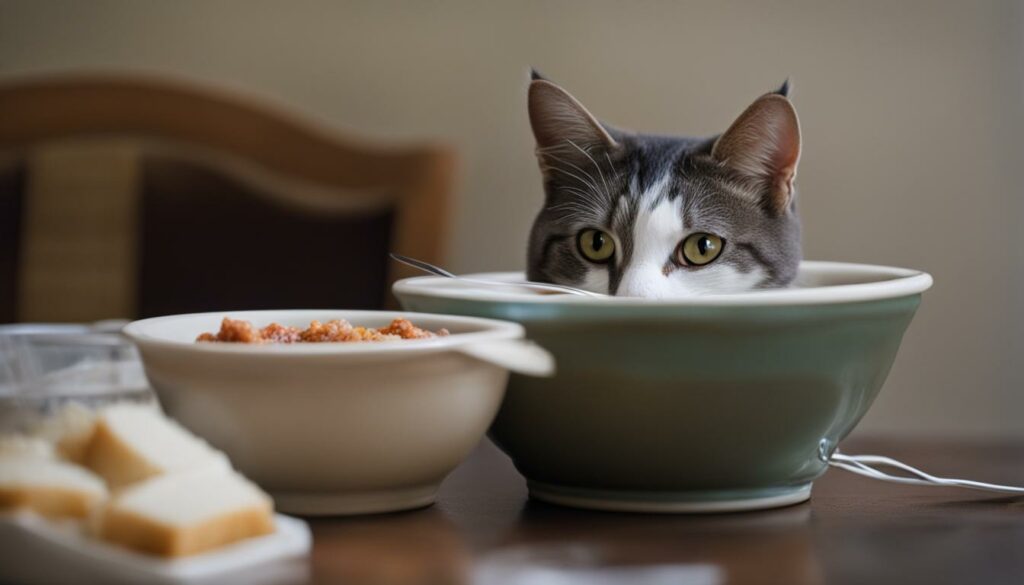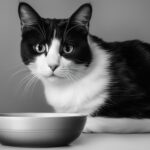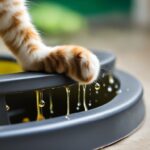If you’ve noticed that your cat is not eating after receiving IV fluids, it can be concerning. As a cat owner, I understand the importance of ensuring your feline friend’s well-being, so let’s explore the possible reasons and solutions for this behavior.
After your cat has received IV fluids, their appetite may be affected for various reasons. It could be related to the type of food being offered, underlying medical conditions, or stress and behavioral issues. It’s essential to address this issue promptly to encourage your cat to eat again and ensure their overall health.
Key Takeaways:
- It is not uncommon for cats to experience a loss of appetite after receiving IV fluids.
- The type of food being offered can play a role in your cat’s reluctance to eat.
- Underlying medical conditions, such as kidney disease or pancreatitis, can cause nausea and decreased appetite.
- Stress or behavioral issues, like associating certain foods with negative experiences, can contribute to a cat’s refusal to eat.
- Consulting with your veterinarian and exploring different solutions can help encourage your cat to eat again.
What are Intravenous Fluids?
Intravenous (IV) fluids, also known as fluid therapy, are a vital part of medical treatment for cats. IV fluids are administered directly into the cat’s vein using a drip, delivering a solution that is compatible with the body’s tissues. These fluids serve multiple purposes, including rehydration, elimination of toxins, and support for various medical conditions. Lactated ringers solution (LRS) is a commonly used fluid in IV therapy.
IV fluids play a crucial role in rehydrating cats who are severely dehydrated due to illness or medical conditions. The fluids help replenish lost fluids in the body and restore the balance of electrolytes. In addition to rehydration, IV fluids can help flush out toxins from the kidneys and support kidney function. IV therapy is typically performed in a hospital setting under the supervision of a veterinarian to ensure proper administration and monitoring of the cat’s response to treatment.
Fluid therapy is not limited to just water; the fluids administered include a combination of electrolytes, vitamins, and other necessary components to support the cat’s health. The specific type and amount of IV fluids are determined by the cat’s condition and medical needs. The rate of flow of IV fluids is carefully regulated to ensure it is neither too fast nor too slow, preventing any potential complications.
Overall, intravenous fluids are a critical aspect of veterinary medicine, providing essential support to cats who are sick or dehydrated. The administration of IV fluids requires professional expertise and veterinary guidance to ensure the safety and well-being of the cat.
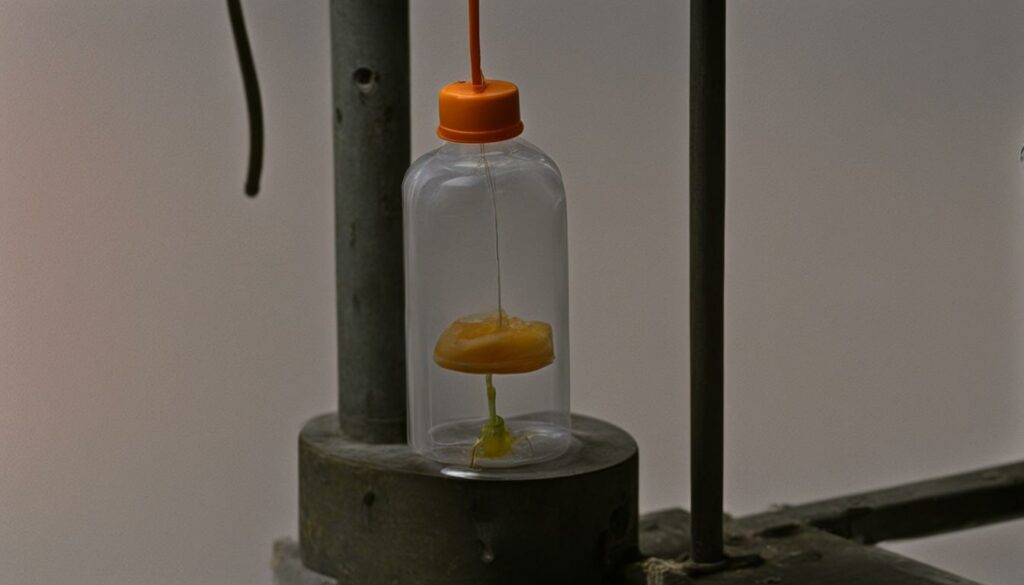
Table: Uses of Intravenous Fluids
| Condition | Reason for IV Fluids |
|---|---|
| Severe dehydration | To rehydrate the cat and restore fluid balance |
| Kidney disease | To flush out toxins and support kidney function |
| Pancreatitis | To provide support and maintain hydration |
| Infections | To aid in the elimination of infectious agents |
| Surgical procedures | To maintain fluid balance and support during anesthesia |
When to Use Intravenous Fluids
Intravenous (IV) fluids are a crucial tool in veterinary medicine for treating cats who are sick or dehydrated. These fluids are typically administered in a hospital or veterinary clinic setting. There are several situations where the use of IV fluids is necessary to provide the necessary support and care to cats in need.
H3>Acute Kidney Injury
One of the common situations where IV fluids are used is in cases of acute kidney injury. Cats with kidney problems may experience a sudden decline in kidney function, leading to dehydration and imbalances in electrolytes. IV fluids can help rehydrate the cat and flush out toxins from the kidneys, supporting their overall kidney function.
H3>Pancreatitis and Infections
IV fluids are also commonly used in cats with conditions like pancreatitis and kidney infections. These illnesses can cause nausea and decreased appetite, making it difficult for cats to eat and stay hydrated. IV fluids provide the necessary hydration and support to help cats recover and regain their appetite.
H3>Pre- and Post-Surgical Care
Prior to surgery, cats may require IV fluids to ensure they are properly hydrated and stable before the procedure. IV fluids can also be used during surgery to maintain blood pressure and support organ function. After surgery, IV fluids may continue to be administered to help with recovery and prevent complications.
H3>Other Situations
There are also other medical conditions or situations where IV fluids may be necessary. These can include treating cats with severe dehydration, managing certain chronic illnesses, supporting cats who are in critical condition, or assisting with other medical treatments that require additional hydration or support.
| Situation | Summary |
|---|---|
| Acute Kidney Injury | IV fluids are used to rehydrate cats and flush out toxins from the kidneys in cases of sudden kidney damage. |
| Pancreatitis and Infections | Cats with pancreatitis or infections may require IV fluids to support their hydration and stimulate appetite. |
| Pre- and Post-Surgical Care | IV fluids are administered before and during surgery to maintain hydration and support organ function. They may also be continued after surgery to aid in recovery. |
| Other Situations | IV fluids may be necessary in various other medical conditions or situations that require additional hydration and support. |
If your cat is experiencing any of these situations or is sick and dehydrated, your veterinarian will determine whether the use of IV fluids is appropriate based on their assessment of your cat’s specific needs and condition.
Where to Administer Intravenous Fluid Therapy
Administering intravenous fluid therapy is a specialized treatment that should be performed by a veterinarian. It is typically done at a veterinary clinic or hospital, where the cat can be closely monitored during the treatment. The veterinary clinic provides a controlled environment with trained professionals who can ensure the safety and effectiveness of the procedure.
During the administration of IV fluids, veterinarians carefully regulate the rate of fluid flow to avoid any complications. This requires expertise and experience to ensure that the flow is neither too fast nor too slow, minimizing the risk of overhydration or underhydration.
Monitoring is a crucial aspect of intravenous fluid therapy. Veterinary professionals monitor the cat’s vital signs, such as heart rate and blood pressure, to ensure the treatment is well-tolerated. They also conduct bloodwork to assess kidney function and electrolyte balances. This monitoring allows them to make any necessary adjustments to the fluid rate or type, ensuring the cat’s safety and optimal response to the treatment.
| Location | Benefits | Considerations |
|---|---|---|
| Veterinary Clinic or Hospital |
|
|
| At-home administration |
|
|
Intravenous fluid therapy should not be administered at home without proper training and guidance from a veterinarian. While at-home administration may seem convenient, it carries risks if not done correctly. It is important to ensure that your cat receives the necessary care and monitoring in a veterinary clinic or hospital setting to optimize their response to the treatment and ensure their overall well-being.
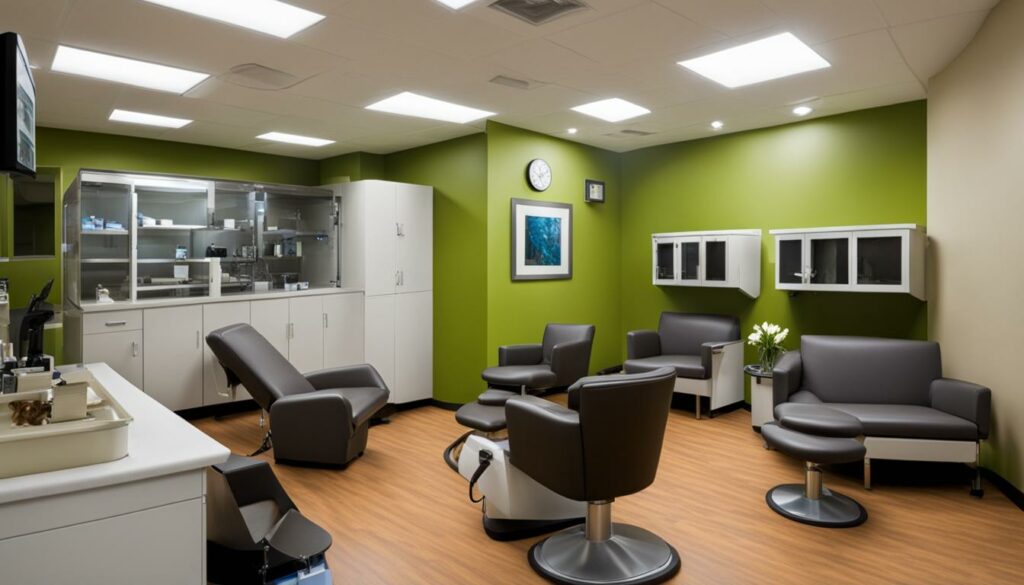
Goals of Intravenous Fluid Therapy for Cats
When it comes to intravenous fluid therapy for cats, the primary goal is to rehydrate them and correct any electrolyte imbalances that may be present. Severe dehydration can occur in cats with conditions like acute kidney injury or chronic kidney disease, and IV fluids are crucial in restoring hydration levels. By providing fluids directly into the bloodstream, the body can absorb them more efficiently, helping to replenish lost fluids and maintain proper hydration levels.
Another important goal of IV fluid therapy is to flush out toxins from the kidneys. In cats with kidney disease, the kidneys may not be functioning properly, leading to a buildup of waste products in the body. IV fluids can help support kidney function and aid in the removal of these toxins, promoting overall kidney health.
Additionally, IV fluid therapy can help stabilize a cat’s electrolyte balance. Electrolytes are essential for proper bodily function, and imbalances can occur in cats with certain medical conditions. By carefully monitoring and adjusting the composition of IV fluids, veterinarians can help restore electrolyte balance and ensure optimal health for the cat.
| Goals of IV Fluid Therapy for Cats | Benefits |
|---|---|
| Rehydration | Restores hydration levels in cats with severe dehydration |
| Toxin Removal | Flushes out toxins from the kidneys, supporting kidney function |
| Electrolyte Balance | Stabilizes electrolyte levels to promote optimal bodily function |
“The primary goal of IV fluid therapy in cats is typically to rehydrate them. Severely dehydrated cats, such as those with acute kidney injury or crashing from chronic kidney disease, may require IV fluids to correct the dehydration and any resulting electrolyte imbalances.” – (Veterinarian Name)
In summary, the goals of IV fluid therapy for cats are to rehydrate the body, flush out toxins from the kidneys, and restore electrolyte balance. By achieving these objectives, IV fluid therapy can play a crucial role in the overall health and well-being of cats, particularly those with conditions that affect hydration levels and kidney function.
Monitoring during Intravenous Fluid Therapy
During intravenous fluid therapy, it is crucial to closely monitor your cat’s response to the treatment. Close monitoring allows veterinarians to assess the cat’s vital signs and evaluate their overall well-being throughout the therapy. By carefully observing their vital signs, such as heart rate and blood pressure, veterinarians can ensure that the cat is tolerating the treatment well and that any necessary adjustments can be made promptly.
Regular bloodwork is an essential part of monitoring during IV fluid therapy. Blood tests allow veterinarians to evaluate important parameters such as kidney function and electrolyte balances, providing valuable insights into the cat’s overall health status. These tests help ensure that the fluid therapy is effectively addressing any imbalances and supporting the cat’s kidney function.
In addition to vital signs monitoring and bloodwork, veterinarians also consider other factors such as the cat’s hydration status, urine output, and overall behavior. By taking a comprehensive approach to monitoring, veterinarians can quickly identify any potential issues or complications and make necessary adjustments to the IV fluid therapy.
Benefits of Close Monitoring
Close monitoring during IV fluid therapy offers several benefits. Firstly, it allows veterinarians to ensure the safety of the cat during the treatment. By closely monitoring vital signs, veterinarians can detect any adverse reactions or complications early on and take appropriate action.
Secondly, close monitoring enables veterinarians to evaluate the effectiveness of the IV fluid therapy. By assessing the cat’s response to the treatment, veterinarians can determine if adjustments are needed to optimize hydration and electrolyte balances. This ensures that the cat is receiving the most appropriate care for their specific needs.
Lastly, close monitoring provides valuable insights into the cat’s overall health and well-being. It allows veterinarians to detect any underlying conditions or complications that may require additional intervention or treatment. By addressing these issues promptly, veterinarians can help improve the cat’s overall prognosis and quality of life.
| Benefits of Close Monitoring during IV Fluid Therapy |
|---|
| Ensures the safety of the cat during the treatment |
| Evaluates the effectiveness of the IV fluid therapy |
| Provides insights into the cat’s overall health and well-being |
Common Reasons Why Cats Won’t Eat After IV Fluids
After receiving IV fluids, some cats may experience a loss of appetite, leading to concerns for their health and well-being. There are several common reasons why cats may refuse to eat after receiving IV fluids:
- Loss of appetite: Cats may have a reduced desire to eat due to the overall discomfort from their medical condition or the stress associated with receiving IV fluids.
- Nausea: Certain medical conditions, such as kidney disease or pancreatitis, can cause nausea and a decrease in appetite. This may result in the cat avoiding food altogether.
- Stress: Cats may become stressed during their hospital stay or while receiving the IV fluids, leading to a temporary loss of appetite.
- Behavioral issues: Cats may associate certain foods with negative experiences, which can lead to a refusal to eat. Additionally, being guarded by other pets during mealtime or changes in the feeding routine can also contribute to food aversion.
It is important to note that cats not eating after IV fluids is not uncommon, but it should be addressed to ensure they receive adequate nutrition for their recovery and overall health.
“Cats may have a reduced desire to eat due to the overall discomfort from their medical condition or the stress associated with receiving IV fluids.”
Understanding and addressing the reasons behind a cat’s refusal to eat after receiving IV fluids is crucial. By identifying the specific factors contributing to their loss of appetite, appropriate steps can be taken to encourage their eating habits and support their recovery. Consultation with a veterinarian is recommended to develop a personalized plan that takes into account the cat’s medical condition, individual needs, and dietary preferences.
| Reasons Why Cats Won’t Eat After IV Fluids | Potential Solutions |
|---|---|
| Loss of appetite | Offering smaller, more frequent meals and using food enhancers to increase palatability |
| Nausea | Consulting with a veterinarian for anti-nausea medications and potentially switching to a different type of food |
| Stress | Creating a calm and quiet environment during mealtime and providing a comfortable eating area |
| Behavioral issues | Gradual desensitization to negative food associations and offering a variety of food textures and flavors |
It is important to be patient and persistent when addressing a cat’s refusal to eat after receiving IV fluids. With time, patience, and the appropriate strategies, most cats will regain their appetite and return to their normal eating habits.
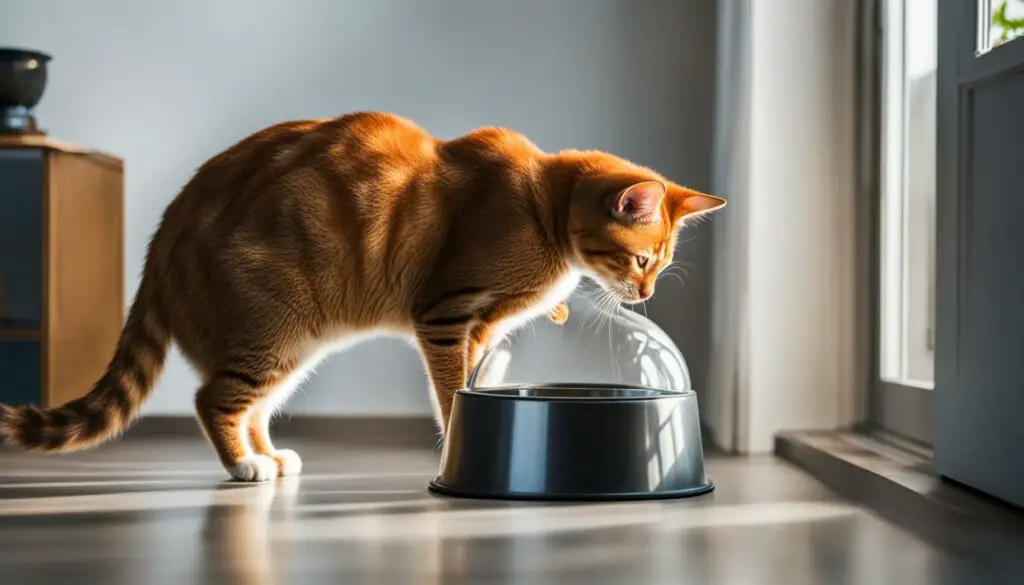
Solutions for Encouraging Your Cat to Eat After IV Fluids
If your cat is not eating after receiving IV fluids, there are several solutions you can try to encourage their appetite. It can be concerning when your cat refuses to eat, but there are steps you can take to help them regain their appetite.
1. Warming up the food: Heating your cat’s food can help enhance the aroma and make it more appealing. Warm food may entice your cat to eat, especially if they are experiencing a decrease in appetite.
2. Offering different textures: Cats can be finicky eaters, and sometimes a change in texture or flavor can stimulate their appetite. You can try offering wet food instead of dry kibble or include some variety in their diet with different flavors or textures.
3. Patience and gradual introduction: It’s important to be patient when trying to get your cat to eat after IV fluids. Slowly reintroduce food and monitor their response. Start with small portions and gradually increase the amount as they regain their appetite.
| Solutions for Encouraging Your Cat to Eat After IV Fluids |
|---|
| 1. Warming up the food |
| 2. Offering different textures |
| 3. Patience and gradual introduction |
Remember that every cat is different, and what works for one may not work for another. If your cat continues to refuse food or shows other concerning symptoms, it is best to consult with your veterinarian for further guidance and assessment.
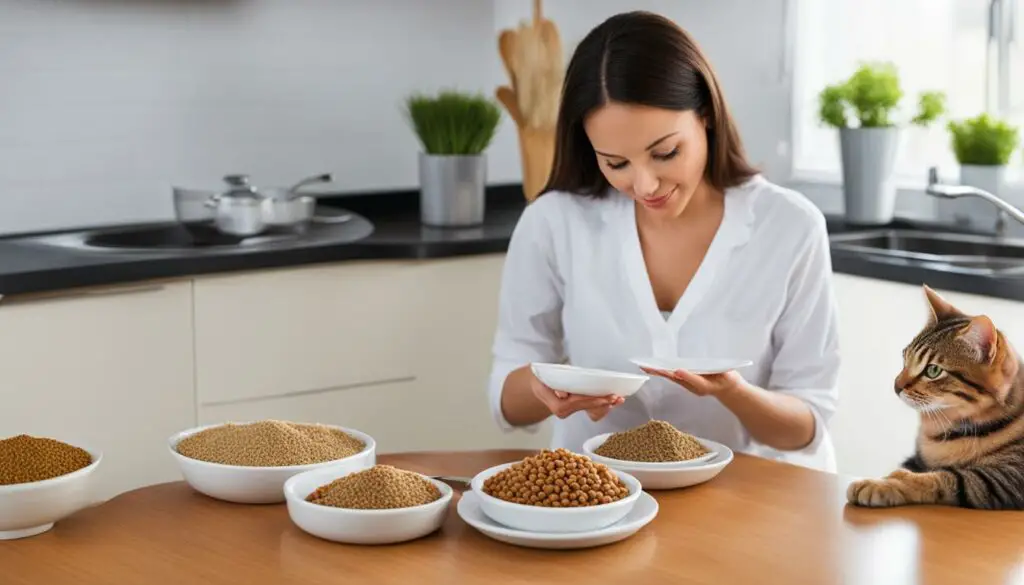
Precautions and What to Expect After IV Fluid Treatment
After your cat has received IV fluid treatment, it is important to take certain precautions and provide appropriate post-treatment care at home. Monitoring your cat’s health and well-being is crucial during this time. Here are some important considerations and what you can expect:
Precautions
- Monitor your cat’s appetite: Keep an eye on your cat’s eating habits and ensure they are consuming an adequate amount of food. If your cat continues to have a decreased appetite or refuses to eat, contact your veterinarian.
- Check hydration levels: Monitor your cat’s hydration status by observing their water intake and urine output. If you notice any signs of dehydration, such as sticky gums or decreased urination, contact your veterinarian.
- Observe behavior and activity levels: Pay attention to any changes in your cat’s behavior or activity levels. If you notice lethargy, excessive tiredness, or any unusual symptoms, seek veterinary attention.
- Follow post-treatment care instructions: Your veterinarian may provide specific instructions for post-treatment care. It is important to follow these instructions carefully to ensure the effectiveness of the treatment and the well-being of your cat.
Monitoring at Home
Your veterinarian may recommend monitoring your cat’s vital signs, such as temperature, heart rate, and respiratory rate, at home to ensure they are stable. Additionally, they may advise periodic check-ups or follow-up appointments to evaluate your cat’s response to the IV fluid treatment.
Keep a record of your cat’s progress, including any changes in appetite, behavior, or overall well-being. This information can be helpful during follow-up appointments and can provide valuable insights for your veterinarian.
If you have any concerns or notice any changes in your cat’s condition, it is important to reach out to your veterinarian for guidance and support. They will be able to provide personalized advice and address any ongoing issues or questions you may have.

Other Considerations and When Not to Use Intravenous Fluids
While intravenous (IV) fluid therapy can be beneficial in many cases, there are certain considerations and situations where it may not be appropriate. It’s important to discuss these factors with your veterinarian to determine the best course of action for your cat.
Potential Considerations for IV Fluid Use
- Pre-existing health conditions: Cats with certain health conditions, such as heart disease or fluid overload, may not be suitable candidates for IV fluid therapy. These conditions can make it risky to administer additional fluids.
- Complicated medical history: Cats with complex medical histories or multiple health issues may require a more tailored approach to fluid therapy. Their treatment plan needs to be carefully coordinated to prevent any negative interactions or complications.
- Allergic reactions: While rare, some cats may have allergic reactions to the components present in IV fluids. These reactions can range from mild irritation to severe anaphylaxis. It’s important to monitor your cat closely during the initial administration of IV fluids to identify any adverse reactions.
When Not to Use IV Fluids
There are certain situations where IV fluid therapy may not be recommended or suitable for your cat:
- Dehydration is not severe: If your cat is only mildly dehydrated and can still drink and maintain hydration orally, IV fluid therapy may not be necessary. Your veterinarian may recommend other methods of rehydration, such as encouraging increased water intake or subcutaneous fluid administration.
- Alternative treatments available: In some cases, alternative treatments or management strategies may be more appropriate for your cat’s specific condition. Your veterinarian will evaluate the individual circumstances and recommend the most suitable approach.
It’s crucial to have open and honest communication with your veterinarian to ensure your cat receives the best possible care. Together, you can determine the most effective treatment plan that prioritizes your cat’s well-being and addresses any concerns or limitations related to IV fluid therapy.
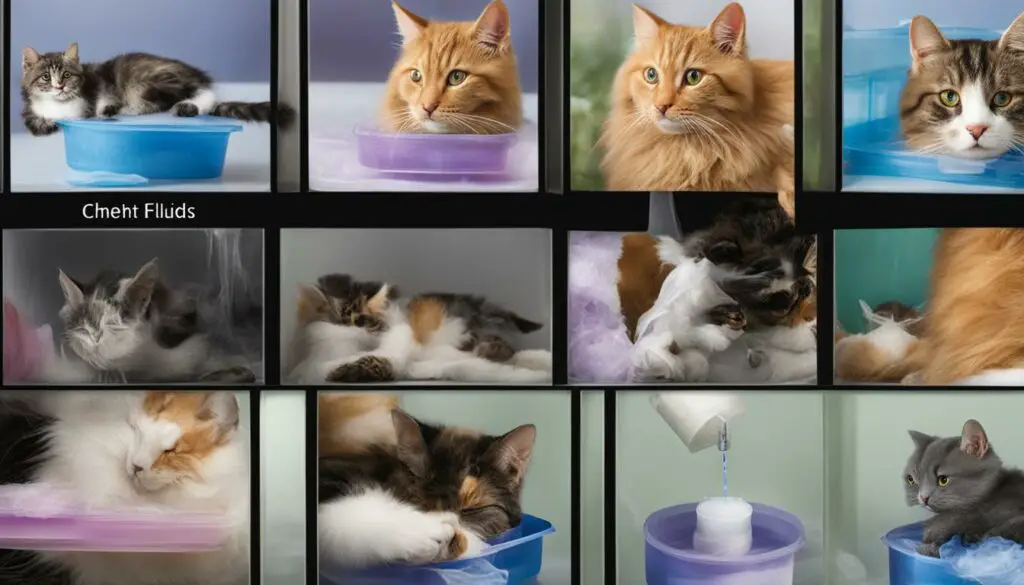
IV Fluid Therapy for Chronic Kidney Disease Cats
Chronic kidney disease (CKD) cats are particularly susceptible to dehydration due to increased urination and potential loss of appetite. In severe cases, CKD cats may require intravenous (IV) fluids to rehydrate them and correct any electrolyte imbalances. This becomes especially crucial in the event of an acute crisis, commonly known as “crashing,” which may serve as the first sign of CKD. The administration of IV fluids can help flush out toxins from the kidneys and support kidney function in CKD cats.
Dehydration is a common issue in CKD cats due to the progressive nature of the disease, which impairs the kidneys’ ability to effectively regulate fluid balance. As a result, these cats may experience increased thirst and urination, leading to dehydration. Administering IV fluids can provide much-needed hydration and help restore electrolyte imbalances in CKD cats, improving their overall well-being and quality of life.
IV fluid therapy serves as a valuable treatment option for CKD cats, particularly during acute crisis situations. By rehydrating the cat and supporting kidney function, IV fluids can help manage the disease and alleviate symptoms associated with dehydration and electrolyte imbalances.
It is essential to note that IV fluid therapy in CKD cats should always be administered under the guidance and supervision of a veterinarian. They will determine the appropriate fluid types, rates, and duration of therapy based on the cat’s individual needs and condition. Regular monitoring and follow-up appointments are crucial to assess the effectiveness of the treatment and make any necessary adjustments.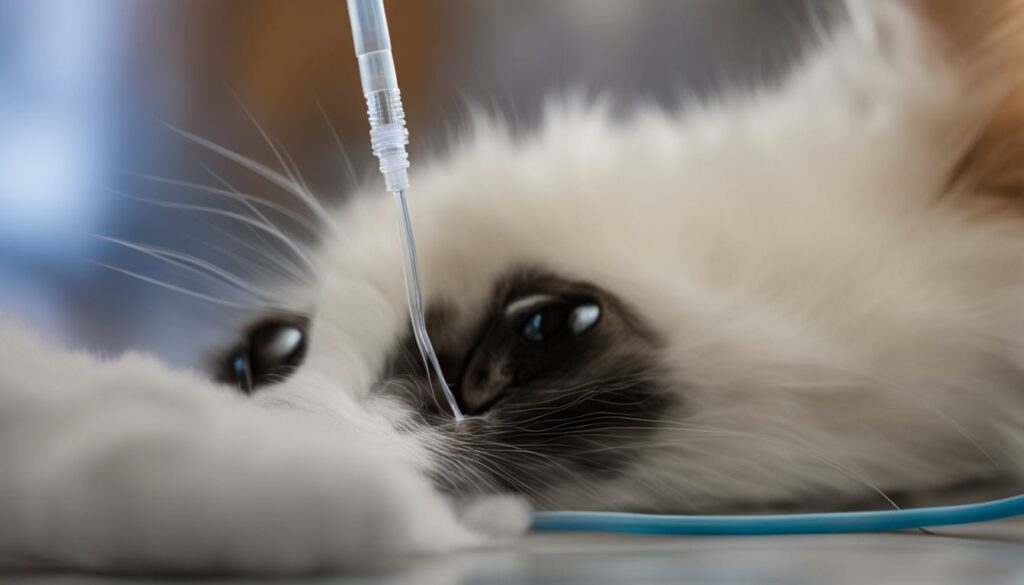
IV Fluid Therapy vs. Subcutaneous Fluids
While IV fluids are commonly used in acute crisis situations for CKD cats, subcutaneous fluids can be an alternative method of providing hydration in a home environment for cats with chronic health issues. Subcutaneous fluids are injected under the cat’s skin near the spine and are absorbed slowly over time. However, it is important to note that subcutaneous fluids are not as effective as IV fluids in rapidly rehydrating a cat or correcting severe electrolyte imbalances. Therefore, they are generally not recommended for cats with acute kidney failure or severe dehydration.
When using subcutaneous fluids, it is crucial to follow proper administration techniques and consult with a veterinarian for guidance. They can provide detailed instructions on the correct administration site, fluid amounts, and frequency of treatments. Regular monitoring of hydration levels and overall well-being is also essential to ensure that the cat’s condition is adequately managed.
Summary
IV fluid therapy plays a vital role in managing dehydration and electrolyte imbalances in CKD cats, especially during acute crisis situations. By rehydrating the cat and supporting kidney function, IV fluids help alleviate symptoms and improve the overall well-being of these cats. However, it is crucial to seek veterinary guidance and supervision throughout the treatment process to ensure the cat’s safety and optimal response to therapy. Subcutaneous fluids can be an alternative option for providing hydration in a home environment, but they are not as effective as IV fluids in cases of acute kidney failure or severe dehydration.
Subcutaneous Fluids as an Alternative to IV Fluids
For cats with chronic health issues, such as kidney disease, subcutaneous fluids can be an alternative to intravenous (IV) fluids. This method involves administering fluids under the cat’s skin, near the spine, and can be done at home with the proper guidance from a veterinarian. While subcutaneous fluids are not as effective as IV fluids in terms of hydration, they can still provide valuable support for cats with chronic conditions.
Administering subcutaneous fluids at home requires some preparation and training, but it can be a beneficial option for cat owners. The process involves using a needle and a bag of fluids, which are typically prescribed by a veterinarian. The fluids are slowly infused under the skin using a small needle, allowing them to be absorbed into the body over time. This method can help replenish a cat’s hydration levels and maintain electrolyte balance.
It is important to closely follow the instructions provided by your veterinarian when administering subcutaneous fluids at home. They can guide you on the appropriate amount of fluids to administer, the frequency of treatments, and any other specific considerations for your cat’s condition. Regular check-ups with your veterinarian may also be recommended to monitor your cat’s response to the treatment and make any necessary adjustments.
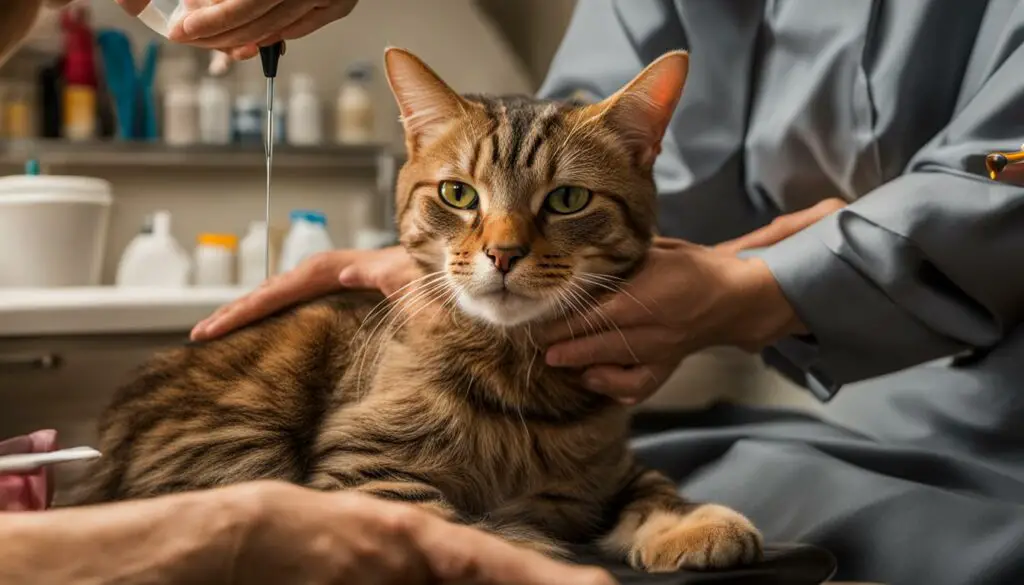
The Importance of Veterinary Guidance for Fluid Administration
When it comes to administering fluids to your cat, whether it’s intravenous (IV) or subcutaneous, veterinary guidance and supervision are of utmost importance. The safety and well-being of your cat should always be the top priority, and administering fluids at home requires the right equipment and proper training.
Veterinarians undergo extensive professional training to learn the techniques and precautions necessary for fluid administration. They have the knowledge and experience to accurately assess your cat’s condition, determine the appropriate type and amount of fluids needed, and ensure that the administration process is done correctly.
Administering fluids at home without veterinary guidance can be risky and may lead to complications or adverse effects. It’s important to understand that different cats may have unique needs and considerations, and a one-size-fits-all approach may not be suitable. Working closely with your veterinarian ensures that the fluid administration is tailored to your cat’s specific requirements.
By seeking veterinary guidance for fluid administration, you can have peace of mind knowing that your cat is receiving the safest and most effective care. Your veterinarian can provide you with the necessary guidance, demonstrate the proper technique, and offer ongoing support to ensure that the fluid administration process is done in the best way possible.
Behavioral Issues and Stress Related to Cat’s Eating Habits
Cats‘ eating habits can be influenced by various behavioral issues and stress factors, leading to food aversions and a reduced appetite. It is important to understand and address these underlying causes to ensure your cat’s overall well-being and nutritional health.
Stress plays a significant role in a cat’s eating habits. Cats can experience stress due to changes in their environment, such as moving to a new home, the introduction of a new pet, or loud noises. Stress can cause a loss of appetite and reluctance to eat, as well as food aversions. Creating a calm and comfortable eating environment for your cat can help alleviate stress and encourage them to eat.
Behavioral issues can also affect a cat’s appetite. Negative experiences associated with certain foods, such as vomiting or other digestive discomfort, can create food aversions. Cats may associate these negative experiences with specific textures or flavors, leading them to refuse to eat certain types of food. Gradual desensitization, positive reinforcement techniques, and offering different textures or flavors can help overcome food aversions and improve your cat’s eating habits.
Consulting with a veterinarian is essential if your cat’s eating habits are affected by behavioral issues or stress. They can provide guidance and recommendations tailored to your cat’s specific needs, helping you create a feeding routine and environment that promotes a healthy appetite. By addressing these issues, you can ensure that your cat receives adequate nutrition and maintain their overall well-being.

Table: Factors That Can Contribute to Behavioral Issues and Stress in Cats
| Factors | Effects on Eating Habits |
|---|---|
| Changes in environment | Loss of appetite, food aversions |
| Introduction of a new pet | Stress, competition for food |
| Loud noises | Loss of appetite, anxiety |
| Negative experiences with food | Food aversions, refusal to eat certain textures or flavors |
Conclusion
If your cat is not eating after receiving IV fluids, it can be concerning. However, there are solutions that can help encourage their appetite and ensure their overall well-being.
First, consider the type of food being offered. Sometimes a simple change in texture or taste can make a big difference. Try warming up the food to enhance the smell and make it more enticing for your cat to eat. Additionally, offering different textures or flavors of food can stimulate their appetite and pique their interest.
If your cat continues to refuse food, it’s important to address any underlying medical conditions that may be affecting their appetite. Consult with your veterinarian to evaluate if there are any medical issues that need to be managed or treated. They can provide personalized advice and guidance to help get your cat’s appetite back on track.
Lastly, it’s crucial to create a calm and stress-free environment during mealtime. Cats can develop food aversions or exhibit reduced appetite due to stress or negative experiences. Make sure your cat feels safe and comfortable while eating, and consider gradual desensitization and positive reinforcement techniques to overcome any food aversions or behavioral issues.
FAQ
Why is my cat not eating after receiving IV fluids?
There can be various reasons why a cat may not eat after receiving IV fluids, including the type of food being offered, medical conditions affecting appetite, and stress or behavioral issues.
What are intravenous fluids?
Intravenous fluids, commonly known as IV fluids, are administered through a vein using a drip. They are used to treat cats who are sick or dehydrated and provide rehydration and other therapeutic benefits.
When should intravenous fluids be used in cats?
Intravenous fluids are typically used in cases of acute illness, severe dehydration, certain medical conditions such as kidney disease or pancreatitis, and before or during surgery. The decision to use IV fluids is made by a veterinarian based on the cat’s specific needs and condition.
Where is intravenous fluid therapy administered?
Intravenous fluid therapy is typically administered at a veterinary clinic or hospital setting where the cat can be closely monitored during the treatment. It requires skilled administration by a veterinarian.
What are the goals of intravenous fluid therapy for cats?
The primary goal of intravenous fluid therapy in cats is typically to rehydrate them and correct any electrolyte imbalances. IV fluids can also help flush out toxins from the kidneys and support overall kidney function, among other therapeutic objectives.
What is involved in monitoring during intravenous fluid therapy?
Monitoring during intravenous fluid therapy involves closely observing the cat’s vital signs, such as heart rate and blood pressure, as well as evaluating kidney function and electrolyte balances through bloodwork. This helps determine the cat’s response to the treatment and ensures their safety and well-being.
What are some common reasons why cats won’t eat after receiving IV fluids?
Cats may not eat after receiving IV fluids due to various factors, including changes in food texture or taste, medical conditions causing nausea or decreased appetite, and stress or behavioral issues associated with specific foods or other pets.
How can I encourage my cat to eat after receiving IV fluids?
There are several solutions you can try to encourage your cat’s appetite, such as warming up the food to enhance its smell, offering different textures or flavors, and creating a calm and comfortable environment during mealtime. It is important to be patient and consult your veterinarian for personalized advice.
What precautions should I take after my cat receives IV fluid treatment?
It is important to follow any post-treatment care instructions provided by your veterinarian, monitor your cat’s appetite and hydration at home, and report any concerns or changes in their condition. Regular follow-up appointments may also be necessary.
Are there situations where intravenous fluids may not be appropriate?
Yes, there are certain health conditions or complications that may make intravenous fluids risky or ineffective. In such cases, alternative treatments or management strategies may be recommended by your veterinarian. It is important to discuss all options and concerns with them.
How can IV fluid therapy help cats with chronic kidney disease (CKD)?
Cats with CKD are prone to dehydration and may require IV fluids to rehydrate them, correct electrolyte imbalances, and support kidney function. IV fluids can be particularly crucial during acute crises or when there are signs of the disease progressing.
What is the difference between intravenous fluids and subcutaneous fluids?
Intravenous fluids are administered directly into a vein using a drip, whereas subcutaneous fluids are injected under the cat’s skin near the spine. Subcutaneous fluids can be administered at home but are not as effective as IV fluids and are typically used for managing certain chronic health issues.
How important is veterinary guidance for fluid administration?
Veterinary guidance is crucial for fluid administration, whether it’s IV or subcutaneous fluids. Administering fluids at home requires the right equipment, proper training, and ongoing supervision to ensure the safety and well-being of your cat.
Can behavioral issues and stress affect a cat’s eating habits after IV fluids?
Yes, stress and behavioral issues can significantly impact a cat’s eating habits. Cats may develop food aversions or exhibit reduced appetite due to stressful situations or negative experiences associated with certain foods. Creating a calm environment and using desensitization techniques can help address these issues.

